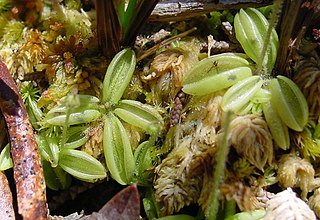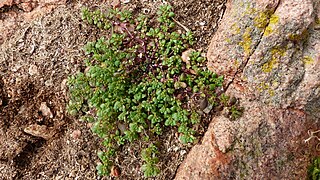
Prunus subg. Padus is a subgenus of Prunus, characterised by having racemose inflorescences. Padus was originally a distinct genus, but genetic and morphological studies have shown that Padus is polyphyletic. It has been proposed that all the racemose taxa within Prunus are incorporated into a broad-sense Prunus subg. Padus. However, this broad-sense Prunus subg. Padus is not monophyletic either.

Ernst Rudolf von Trautvetter, was a Baltic German botanist, specialising in the flora of the Caucasus and central Asia.

Cupressus lusitanica, the Mexican cedar or cedar-of-Goa, is a species of cypress native to Mexico and Central America. It has also been introduced to Belize, Costa Rica and Nicaragua, growing at 1,200–3,000 metres (3,900–9,800 ft) altitude.

Iris xiphium, commonly known as the Spanish iris, is an iris native to Spain and Portugal. It has also been found in Corsica, South West France, southern Italy, Algeria and Tunisia. This species is also known as the small bulbous-rooted iris.

Pinguicula lusitanica, commonly known as the pale butterwort, is a small butterwort that grows wild in acidic peat bog areas along coastal atlantic western Europe from western Scotland and Ireland south through western England and western France to the Iberian Peninsula and Morocco in north-western Africa.

Dactylis glomerata, also known as cock's-foot, orchard grass, or cat grass (due to its popularity for use with domestic cats) is a common species of grass in the genus Dactylis. It is a cool-season perennial C3 bunchgrass native throughout most of Europe, temperate Asia, and northern Africa.
The Habitats Directive is a directive adopted by the European Community in 1992 as a response to the Berne Convention. The European Community was reformed as the European Union the following year, but the directive is still recognised.

Prunus lusitanica, the Portuguese laurel cherry or Portugal laurel, is a species of flowering plant in the rose family Rosaceae, native to southwestern France, Spain, Portugal, Morocco, and Macaronesia.

Campanula rapunculus, common name rampion bellflower, rampion, rover bellflower, or rapunzel, is a species of bellflower (Campanula) in the family Campanulaceae.

Parietaria is a genus of flowering plants in the family Urticaceae, native to temperate and tropical regions across the world.

Quercus lusitanica, commonly known as gall oak, Lusitanian oak, or dyer's oak, is a species of oak native to Portugal, Spain and Morocco. Quercus lusitanica is the source of commercial nutgalls. These galls are produced by the infection from the insect Cynips gallae tinctoriae. They are used for dyeing.

Herniaria hirsuta is a species of flowering plant in the family Caryophyllaceae known by the common name hairy rupturewort. It is native to Eurasia and North Africa, and it is known on other continents, including North America, as an introduced species. This is an annual herb with stems up to 20 cm (8 in) long usually growing prostrate along the ground. The small, fuzzy, pale green leaves are up to about a centimeter long and coat the stems. The inflorescences appear in the leaf axils. Each contains three to eight hairy green sepals and no petals. The fruit is a tiny bumpy utricle containing one seed.
Selenemys is an extinct genus of pleurosternid turtle from the Late Jurassic of Central West of Portugal. It is known from several specimens recovered from the Lusitanian Basin, dating to the upper Kimmeridgian age. It was one of the earliest European pleurosternids, more closely related to the later Cretaceous pleurosternids of Europe than the contemporary pleurosternids of North America. This genus was named by Adán Pérez-García and Francisco Ortega in 2011, and the type species is Selenemys lusitanica.

Pinguicula, commonly known as the butterworts, is a genus of carnivorous flowering plants in the family Lentibulariaceae. They use sticky, glandular leaves to lure, trap, and digest insects in order to supplement the poor mineral nutrition they obtain from the environment. Of the roughly 80 currently known species, 13 are native to Europe, 9 to North America, and some to northern Asia. The largest number of species is in South and Central America.

Helictochloa is a genus of Eurasian, North African, and North American plants in the grass family.

Fritillaria lusitanica is a species of plant in the lily family Liliaceae, endemic to the Iberian Peninsula.

Herniaria lusitanica is a species of flowering plant in the family Caryophyllales. It is endemic to the Iberian Peninsula and the Berlengas archipelago.

Herniaria lusitanica subsp. berlengiana is an endangered subspecies of flowering plant in the family Caryophyllaceae. It is endemic to the Berlengas Archipelago, Portugal.

Herniaria cinerea is a species of herb in the family Caryophyllaceae (carpetweeds).















